THE EFFICACY OF TIKTOK SHORT VIDEO TO ELEVATE THE STUDENTS’ ACHIEVEMENT ON THE VOCABULARY LEARNING: THE EXPERIMENTAL STUDY IN SMP NEGERI 3 SUTOJAYAN
DOI:
https://doi.org/10.37478/jpm.v6i1.4738Abstract
This study aims to investigate the efficacy of TikTok short videos as a tool to improve students' achievement in vocabulary learning at SMP Negeri 3 Sutojayan Blitar. The research employs a pre-experimental design with a one-group pre-test and post-test methodology. A total of 30 seventh-grade students from Class 7A were involved during the period of April to May 2024. Data were collected through a pre-test, a treatment session involving TikTok videos, and a post-test to measure the improvement in students' vocabulary. The analysis was conducted using quantitative methods based on Sugiyono's (2019) framework. The results of the study indicate that the use of TikTok short videos significantly improved students' performance in vocabulary learning. The study concludes that integrating social media platforms such as TikTok can be an effective strategy in vocabulary learning, offering an engaging blend of entertainment and education. The study recommends further research to explore the use of other digital tools in education.
Downloads
Keywords:
TikTok short videos, Vocabulary learningReferences
Algarabel, S., & Dasi, C. (2001). The definition of achievement and the construction of tests for its measurement: A review of the main trends. Psicologica, 22(1), 43-66. https://www.redalyc.org/pdf/169/16917746001.pdf
Bintz, W. P. (2011). Teaching vocabulary across the curriculum. Middle School Journal, 42(4), 44–53. https://doi.org/10.1080/00940771.2011.11461773
Bohang, F. K., & Wahyudi, R. (2018). Tik Tok Punya 10 Juta Pengguna Aktif di Indonesia. https://tekno.kompas.com/read/2018/07/05/09531027/tik-tok-punya-10-juta-pengguna-aktif-di-indonesia
Cahyono, B. Y., & Widiati, U. (2008). The teaching of EFL vocabulary in the Indonesian context: the state of the art. TEFLIN, 19(1), 2. https://pdfs.semanticscholar.org/3c4b/dd11908110ce7ed4af9599f62736144306b1.pdf
Cantika, L. (2023). Improving Students Vocabulary Mastery By Using Tik-Tok Application For The Eighth Graders Of SMP Muhammadiyah 4 Metro. IAIN Metro. https://repository.metrouniv.ac.id/id/eprint/8754
Chaidirman, C., Indriastuti, D., & Narmi, N. (2019). Fenomena kecanduan penggunaan gawai (gadget) pada kalangan remaja Suku Bajo. Holistic Nursing and Health Science, 2(2), 33–41. https://ejournal2.undip.ac.id/index.php/hnhs/article/view/6954
Erwani, I., Romi, M. J., Sawithy, M. N., Rohana, R., Ulfah, S., & Supeni, I. (2022). The influence of Tiktok in increasing vocabulary for Elementary School in SMP 1 Muhammadiyah Banjarbaru. Elite Journal, 4(1), 25–40.https://www.elitejournal.org/index.php/ELITE/article/view/77
Ernia, L. (2024). The Effectiveness of Tiktok Application to Improve Students’ Vocabulary: a Study of Eighth Grade at MTS MT Belanting. Universitas Mataram. https://eprints.unram.ac.id/44855
Firdaus, A. A. (2021). Dampak Covid-19 Terhadap Kebijakan Pendidikan Di Indonesia: Antara Idealisme Dan Realitas. UAD PRESS. https://journal.uny.ac.id/index.php/jamp/article/view/46116
Hartatiningsih, D. (2022). Meningkatkan Penguasaan Vocabulary Bahasa Inggris Dengan Menggunakan Media Wordwall Siswa Kelas VII Mts. Guppi Kresnomulyo. ACTION: Jurnal Inovasi Penelitian Tindakan Kelas Dan Sekolah, 2(3), 303-312. https://doi.org/10.51878/action.v2i3.1443
Hatch, E., & Brown, C. (1995). Vocabulary, semantics, and language education. ERIC. https://eric.ed.gov/?id=ED396578
Hiebert, E. H., & Kamil, M. L. (2005). Teaching and learning vocabulary: Bringing research to practice. Routledge. https://doi.org/10.4324/9781410612922
Hornby, A. S. (2006). Oxford advanced learner’s dictionary. New York: Oxford University. https://www.oxfordlearnersdictionaries.com
Husamah. (2014). Pembelajaran bauran (Blended learning). Research Report. https://uad.ac.id
Ichara Sinta, Z. (2022). Students’ Experience in Vocabulary Memorizing of Adjective by Using TikTok Duet Video. Cybernetics: Journal Educational Research and Social Studies, 40–52. https://doi.org/10.51178/cjerss.v3i1.366
Laufer, B., & Goldstein, Z. (2004). Testing vocabulary knowledge: Size, strength, and computer adaptiveness. Language Learning, 54(3), 399–436. https://onlinelibrary.wiley.com/doi/abs/10.1111/j.1467-9922.2004.00267.x
Linse, C., & Nunan, D. (2005). Practical English language teaching. New York, 24. https://bibliotecadigital.mineduc.cl/handle/20.500.12365/17882
Mailani, O., Nuraeni, I., Syakila, S. A., & Lazuardi, J. (2022). Bahasa sebagai alat komunikasi dalam kehidupan manusia. Kampret Journal, 1(2), 1–10. https://doi.org/10.35335/kampret.v1i1.8
Maindoka, R. A., Olii, S. T., & Rorimpandey, R. (2022). Improving Students’ Vocabulary Mastery Through Word Wall Technique. SoCul: International Journal of Research in Social Cultural Issues, 2(3), 564–570. https://ejournal.ust.ac.id/index.php/KAIROS/article/view/2154
Niemi, P. M., & Vainiomäki, P. T. (1999). Medical students’ academic distress, coping, and achievement strategies during the preclinical years. Teaching and Learning in Medicine, 11(3), 125–134. https://doi.org/10.1207/S15328015TL110302
Ningtias, W. (2017). Improving Students’ Vocabulary in Descriptive Text by Using Climbing Up The Ladder Game. Jurnal Pendidikan dan Pembelajaran Khatulistiwa (JPPK), 6(8). http://dx.doi.org/10.26418/jppk.v6i8.21224
Rahajeng, R. S. (2022). Pengaruh aplikasi tiktok terhadap perkembangan sosial emosional anak usia dini di kabupaten magetan. Universitas Muhammadiyah Ponorogo. http://eprints.umpo.ac.id/id/eprint/8622
Rohmah, S. K. (2019). Analisis Learning Obstacles Siswa pada Materi Pecahan Kelas IV Sekolah Dasar. Al-Aulad: Journal of Islamic Primary Education, 2(1). https://doi.org/10.15575/al-aulad.v2i1.4428
Sanjaya, D. (2013). TPS AS AN EFFECTIVE TECHNIQUE TO ENHANCE THE STUDENTS’ ACHIEVEMENT ON WRITING DESCRIPTIVE TEXT. English Language Teaching, 6(12), 106–113. https://doi.org/10.5539/elt.v6n12p106
Sugiyono, S. (2019). Metode Penelitian Kuantitatif, Kualitatif, dan R&D. Bandung: CV. Alfabeta. Google Scholar
Tampubolon, A. R., Siahaan, B. L., & Sitanggang, A. (2023). The Effect Of Using Tiktok On Students’ Vocabulary Mastery In Seventh Grade At SMP Negeri 9 Pematang Siantar. Jurnal Ilmu Pendidikan Dan Sosial, 2(3), 390–402. https://doi.org/10.58540/jipsi.v2i3.446
Thornbury, S. (2002). How to teach vocabulary. Pearson Education Limited. England. https://thuvienso.hoasen.edu.vn/handle/123456789/9766
Downloads
Published
How to Cite
Issue
Section
License
Copyright (c) 2025 Silvi Wahyu Herida Saputri, Hesty Puspita Sari, Yusniarsi Primasari, Supriyono Supriyono

This work is licensed under a Creative Commons Attribution-ShareAlike 4.0 International License.












